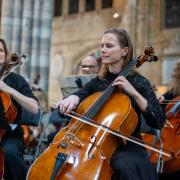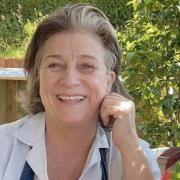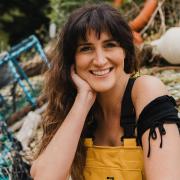CAROLYN SEAGER reveals how long after her mother’s death she discovered her amazing career in the service of her country

There can be few of us whose hearts didn’t ache as they watched a 12-year-old Prince Harry walking behind his mother’s coffin in 1997. Memories of my own mother’s funeral in 1977 came surging back to me, for I too was near Harry’s age when I lost my mother.
Harry might forever carry painful memories of his mother’s funeral, but I’m sure the Royal Standard in which the Princess’ coffin was draped won’t feature in them. In contrast, the Union Jack that was laid over my mother’s coffin is all I do remember.
The event was so painful I obliterated most of the detail but that flag haunted me. But hey, we were the family who had a signed portrait of Winston Churchill hanging in their 1950s semi. Didn’t everyone?

I remember sharing the sense of paralysing fear Harry must have felt that day. The British mantra of ‘just get on with it’ might have served wartime generations well, but for a child, it’s brutal.
From my Mum’s funeral onwards, our family barely mentioned her. My only memories were a patchwork of Woolacombe surfs, Lundy adventures, wild Exmoor excursions and rainy Saturdays when, inexplicably, I’d be taught Morse Code.
But that was okay for me – the moors and waves of North Devon nurtured me into adulthood and gifted me an imagination I could escape into. Storylines would centre around my Mum, a courageous protagonist of glamour and intrigue. Fast forward 40 years and who would have known that what I’d uncover would be stranger than fiction?

I’d moved house and for the first time set about investigating Mum’s storage boxes. I discovered a Pandora’s Box of World War Two memories.
Tins of letters from Norwegian resistance fighters, sketches of partisan wireless operators, a F.A.N.Y. (First Aid Nursing Yeomanry) uniform, and a plethora of newspaper articles about Norwegian hydro-electric sabotage operations. Last but not least an immaculate Second World War Morse Code wireless.
Tears fell as I read those letters and realised that the man I knew as ‘Uncle Erik from Norway’ was a hydro-electric specialist who’d become a Norwegian resistance fighter codenamed ‘Timian’.

It was he who’d been on the other end of the communications sent by my mother. I don’t know how they’d found each other after the war, but it was friendship they’d keep until their deaths.
I’m now piecing together my mother’s wartime history with the help of the F.A.N.Y. archivists. They explained that when the Special Operations Executive (S.O.E.) was set up in 1940 the F.A.N.Y became their chief source for agents and signal operators.
They confirmed my mother, Mary Jeanette Luxmoore, had been an S.O.E. wireless operator working on special operations after joining the F.A.N.Y in 1943 fresh from Ilfracombe. Following initial training, she’d been sent to Special Training School (STS) 54a at Fawley Court, Henley-On-Thames and then STS 54b at Bellhaven School, East Lothian.

Research is ongoing, but the fact that ‘Uncle Erik’ was a hydro-electric specialist leads me to suspect Mum was part of Operation Grouse or Gunnerside which successfully ended the Nazi Nuclear bomb project.
I might never find out the details…unlike the ‘selfie’ world of today, this was a generation that carried the secret timelines to the grave. What I do know is that although my mother left me early, she has gifted me a legacy that I’m eternally grateful for – a free country of which I’m proud.
Oh, and could it be the mystery of Mr Churchill’s presence hanging in our dining room has been solved? Maybe, and somehow that Union Jack seems right and fitting now.
Lest we forget:
Erik Raestad and Arne Lochen
- By April, 1940 many of Norway’s cities had been seized by the Nazis.
- In June, 1940 the Norwegians surrendered and Erik entered the Norwegian intelligence services. His duties included recording the movements of battleships like the Terpitz.
- He was arrested by the Germans and sent to Falstad Concentration Camp.
- He was put into hard labour at the German navy dockyard where he smuggled out sketches of the Terpitz’s camouflage to his colleagues in the Resistance.
- He was released and went straight into training as a wireless operator with the Norwegian Underground. His code name was Timian.
- Arne Lochen worked as an underground weapons instructor. He was caught by the Nazis and sent to Grini Concentration Camp.
The story of the First Aid Nursing Yeomanry (F.A.N.Y.)
- Originally formed as a WW1 mounted nursing unit in 1907.
- In one night, eighteen were awarded the Military Medal.
- When the Special Operations Executive (S.O.E.) was established in 1940 the F.A.N.Y. became their recruiting ground and a perfect cover for their secret work.
- Over two thousand ‘Fanys’ became secret service women who were dropped into enemy territory or decoded wireless communications from agents.
- Forty-seven ‘Fanys’ saw service ‘in the field’, thirteen died in action.
- The F.A.N.Y (Princess Royal’s Volunteer Corp) still exists today as an all-female voluntary organisation supporting civil and military authorities during times of crisis.
_______________



























